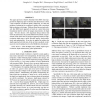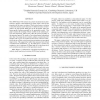1355 search results - page 238 / 271 » icassp 2011 |
ICASSP
2011
IEEE
14 years 1 months ago
2011
IEEE
Dynamic noise adaptation (DNA) [1, 2] is a model-based technique for improving automatic speech recognition (ASR) performance in noise. DNA has shown promise on artificially mixe...
59
Voted
ICASSP
2011
IEEE
14 years 1 months ago
2011
IEEE
The reuse of past coefficient vectors of the NLMS for reducing the steady-state MSD in a low signal-to-noise ratio (SNR) was proposed recently. Its convergence analysis has not b...
77
Voted
ICASSP
2011
IEEE
14 years 1 months ago
2011
IEEE
In this paper we present a number of improvements that were recently made to the template based speech recognition system developed at ESAT. Combining these improvements resulted ...
86
Voted
ICASSP
2011
IEEE
14 years 1 months ago
2011
IEEE
This paper presents a Markov Random Field (MRF)-based approach for depth map super-resolution and enhancement. Given a low-resolution or moderate quality depth map, we study the p...
83
Voted
ICASSP
2011
IEEE
14 years 1 months ago
2011
IEEE
Most HMM-based TTS systems use a hard voiced/unvoiced classification to produce a discontinuous F0 signal which is used for the generation of the source-excitation. When a mixed ...


